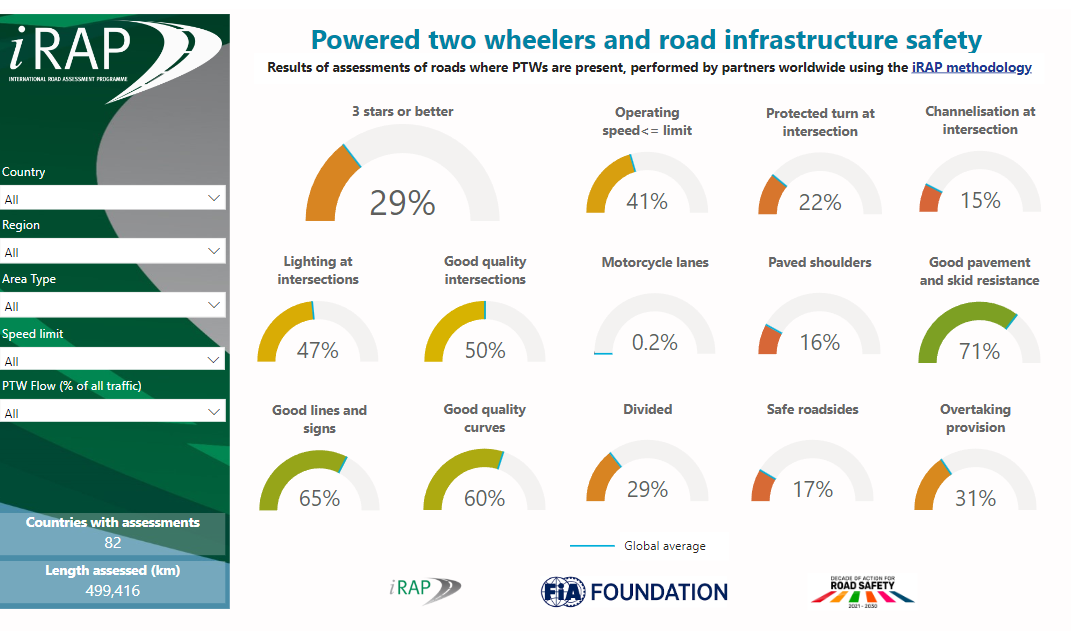Worldwide, the use of Powered Two Wheelers (PTW) is growing rapidly and as a result PTW users are estimated to be the largest group being killed on the world’s roads.
It is estimated that PTW users suffer almost 7 million deaths and injuries each year on the world’s roads at a staggering cost of USD 643 billion per year.[1]
A newly updated report draws on safety assessments performed around the world using the standardized iRAP methodology to provide invaluable insights into the standard of infrastructure provided for PTWs worldwide.
The interactive Powered Two Wheelers and Road Infrastructure Safety report includes data for almost 500,000km of roads that have flows of PTWs in more than 80 countries. The report enables users to filter the data by country, region, area type, flow and speed.
The report highlights the often-perilous state of roads for PTWs, with less than a third (29%) of roads where PTWs are present being rated 3-stars or better (out of 5 stars). The percentage rated 3-stars or better drops to 20% for roads where speed limits are greater than 60km/h – speeds at which risk of death and serious injury are amplified.
The report provides invaluable insights into the opportunities for safety improvements:
- Just 22% of intersections have protected turn lanes (such as roundabouts) and less than half of intersections (47%) have street lighting.
- Only 16% of roads have paved shoulders, which often allow motorcycles to be passed by 4-wheeled vehicles without leaving the main roadway in rural areas.
- Just 29% of roads are divided, which is a significant factor in head-on crashes.
- Only 17% of roadsides are safe, which is a significant factor in run-off road trauma.
- Less than 1% of roads have dedicated motorcycle carriageways, such as those found in Ougadougou, and South East Asia.
- PTW are particularly sensitive to the road surface, but 29% of the roads assessed do not have good pavement condition and skid resistance.
- Vehicle operating speeds are at or below speed limits on only 41% of roads, indicating a need for better efforts to ensure compliance.
iRAP Global Program Director Greg Smith said, “As populations grow and people seek ever more affordable and convenient modes of transportation, PTW use is expected to continue expanding. It’s more important than ever that infrastructure is designed to accommodate both the safety of PTW users and those that interact with them.”
“The growth in PTW presents challenges for planning, design and road management, and certainly more research is needed to support expansion of dedicated PTW carriageways on key corridors”, says Greg, “but we know that getting the basics right is incredibly effective for PTW safety. Good pavements, well-lit and well-managed intersections, safe roadsides, and paved shoulders all help to reduce the risk of death and serious injury.”
The freely available iRAP methodology and tools are designed to help planners, designers and road operators build safety for PTWs into their networks. This includes the CycleRAP tools, which support safety for micromobility and e-bike users.
Approaching the half-way point of the United Nations Decade of Action for Road Safety, which has a goal halving road deaths and injuries by 2030, it is imperative that countries do everything they can to lift the safety standard of roads.
iRAP is also encouraging people to make a Pledge for Safer Roads and Mobility ahead of the 4th Global Ministerial Conference on Road Safety in Morocco in 2025.
[1] For the purposes of this report and the iRAP Safety Insights Explorer, Powered Two Wheelers (PTW) and Motorcycles are used interchangeably.


















